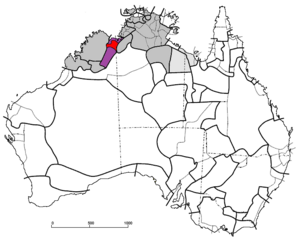Miriwoong language facts for kids
Quick facts for kids Miriwoong |
|
|---|---|
| Region | Kununurra, Western Australia |
| Ethnicity | Miriwung |
| Native speakers | 168 (2021 census) |
| Language family |
Jarrakan
|
| Dialects |
? Dulbung
|
| AIATSIS | K29 |

(red) Miriwoong language
(purple) other Jarrakan languages (grey) other non-Pama-Nyungan languages |
|
Miriwoong, also spelled Miriuwung or Miriwung, is an Aboriginal Australian language. Today, fewer than 20 people speak it fluently. Most of these speakers are older people living near Kununurra in Western Australia.
Because so few people speak it fluently, Miriwoong is considered a critically endangered language. This means it is at high risk of disappearing. However, many younger people know some Miriwoong words. They often use these words when speaking Kimberley Kriol or Aboriginal English.
Contents
What Kind of Language is Miriwoong?
Miriwoong is part of a group of languages called Jarrakan languages. These languages are found in the northern parts of Australia. Linguists (people who study languages) place Miriwoong in a larger group known as Non-Pama-Nyungan languages. This group includes many different Aboriginal languages that are not part of the Pama-Nyungan family, which is the largest group of Aboriginal languages.
Miriwoong Sign Language
Just like many other Aboriginal communities in Australia, the Miriwoong people also use a signed language. This sign language is used alongside their spoken languages. It allows people to communicate using hand gestures and body movements.
Speaking Many Languages
Even though Miriwoong is endangered, the Miriwoong community is very good at speaking many languages. This is called being multilingual.
The languages spoken in the community include:
- Miriwoong (by a small number of fluent speakers)
- The Miriwoong signed language
- Kimberley Kriol (a language that mixes English with Aboriginal languages)
- English
There are two main types of English spoken: Aboriginal English and Standard Australian English. Many people in the community can speak both types of English. Others prefer to speak Aboriginal English.
Helping Miriwoong Survive
The Mirima Dawang Woorlab-gerring Language and Culture Centre works hard to keep the Miriwoong language alive. They have been doing this since the 1970s.
The centre does many things to help the language. These include:
- Language nests: These are like special playgroups or classes where young children learn Miriwoong. About 300 children, both Indigenous and non-Indigenous, attend these every week.
- Public language classes: These classes teach Miriwoong to anyone interested in learning.
- On-country training camps: These camps teach people about the language and culture while out on traditional lands.
A big part of their work is also publishing books in Miriwoong. This helps people read and learn the language.
How Miriwoong Sounds and is Written
Miriwoong Sounds
Miriwoong has its own special set of sounds. It has four main vowel sounds, similar to 'a', 'e', 'i', and 'oo' (like in 'moon'). The length of these vowel sounds doesn't change the meaning of a word.
The language also has 19 consonant sounds. These are the sounds made when you block air with your lips, tongue, or teeth. Miriwoong is typical of many Aboriginal languages because it has several 'l' and 'n' sounds. It also doesn't have 'f' or 'v' sounds, and sounds like 'p', 't', and 'k' are not voiced (meaning your vocal cords don't vibrate when you say them).
How Miriwoong is Written
The way Miriwoong is written down was created by the Mirima Dawang Woorlab-gerring centre. It's mostly a phonemic orthography, which means each letter or group of letters usually stands for one sound.
Some sounds in Miriwoong don't have a single letter in the regular English alphabet. For these, two letters are used together. This is called a digraph. For example, the 'u' sound is written as oo, like in the word joolang (dog).
Here are some examples of Miriwoong words and their English meanings:
| Miriwoong Spelling | English Translation | |
|---|---|---|
| a | dawang | place |
| e | jawaleng | man |
| oo | joolang | dog |
| i | ngirrngiling | cat |
| b | bare | to stand |
| d | dooleng | heart |
| g | goondarring | fish |
| j | wija | swim |
| l | biligirrimawoong | white |
| m | moonamang | magpie goose |
| n | Goonoonooram | Kununurra (river) |
| r | ramang | grass |
| w | woothoony | small (f) |
| y | mayeng | non-meat food |
| ly | bilyiny | tick |
| ng | ngerregoowoong | big |
| nh | ngenhengbeng | red |
| ny | gerany | rock |
| rd | gardag | cup |
| rl | gerloong | water |
| rn | merndang | paper |
| rr | Darram | Bandicoot Bar (place name) |
| th | thegoobeling | black |
The Mirima Dawang Woorlab-gerring centre works with local groups to make sure Miriwoong is written in the same way everywhere, like in documents or signs.
How Miriwoong Sentences Work
Miriwoong has some interesting grammar rules.
Nouns and Gender
In Miriwoong, nouns (words for people, places, or things) have a grammatical gender. This means they are either considered masculine or feminine. Adjectives (words that describe nouns) and demonstratives (words like 'this' or 'that') change to match the gender of the noun they are describing.
Verbs and Actions
Verbs (action words) in Miriwoong often work together. They use a system of coverbs and inflecting verbs.
- Coverbs usually carry the main meaning of the action. They don't change much.
- Inflecting verbs carry the grammar information, like who is doing the action or when it happened.
Both types of verbs can stand alone, but often they are used together to describe an action. There are only about 20 inflecting verbs, but many more coverbs. This way of using verbs is common in many Aboriginal languages, especially in northern Australia.

